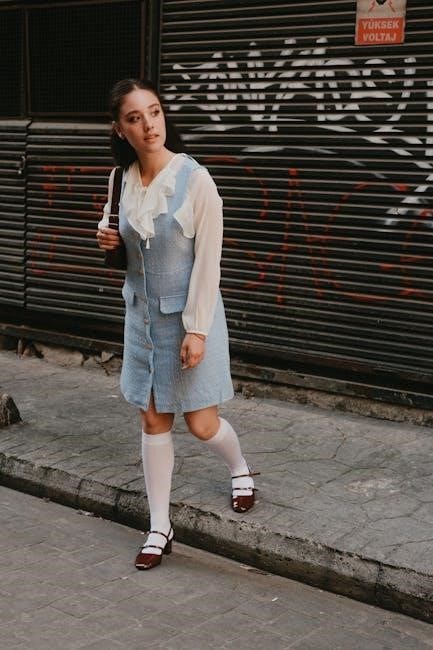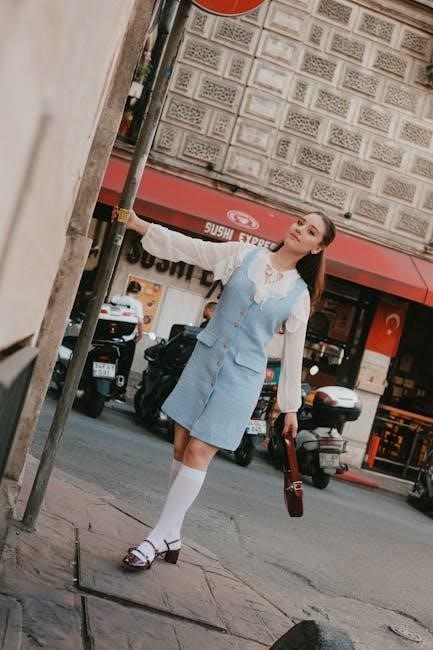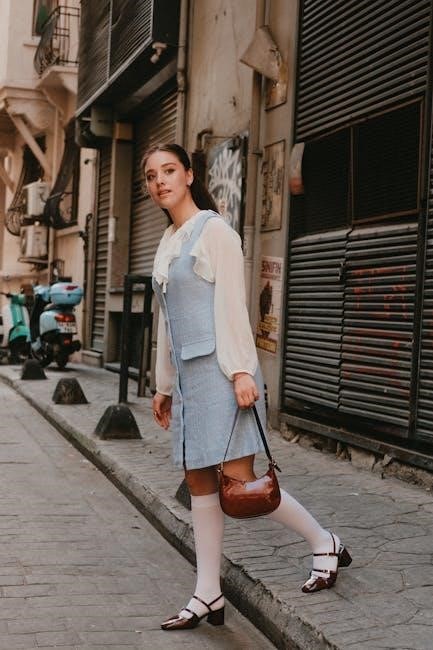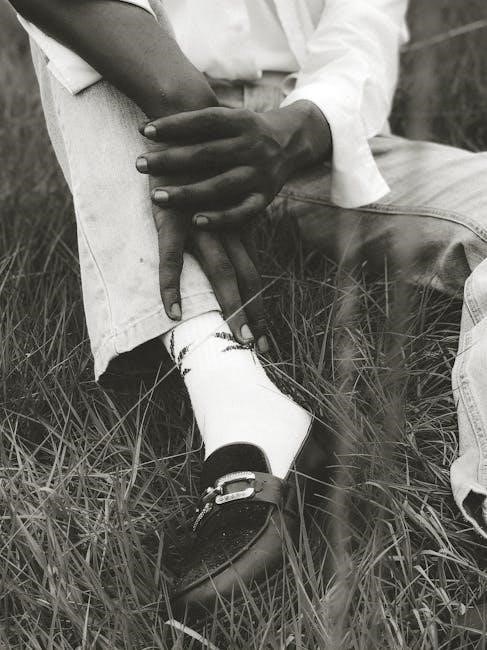
Understanding your sock size is crucial for comfort and fit. This guide helps you determine the perfect size based on foot measurements, ensuring optimal comfort and durability.
Why Knowing Your Sock Size is Important
Knowing your sock size ensures a comfortable and proper fit, preventing issues like blisters, discomfort, and restricted movement. Ill-fitting socks can lead to health problems over time, such as foot pain or poor circulation. Accurate sizing also extends the life of your socks, preventing stretching or tearing. Foot shape and width play a role in fit, so relying solely on shoe size isn’t enough. Different brands may vary in sizing, making it essential to consult size charts for accuracy. Proper fit enhances performance and overall satisfaction.
How to Use This Socks Size Guide
Start by measuring your foot length and width accurately to determine your size. Refer to the standard size charts for adults or kids, matching your measurements to the closest fit. Consider factors like foot shape, activity level, and sock type, as these influence size. Use the guide to explore compression options or unique brand sizing. For the best fit, try socks before buying if possible, and adjust based on seasonal needs or specific activities like hiking or sports.
Understanding Sock Size Measurements
Sock sizes are based on foot length and width, typically measured in inches or centimeters, ensuring a proper fit and comfort for various activities and preferences.
How Sock Sizes Are Determined
Sock sizes are typically determined by measuring foot length and width, similar to shoe sizing. They are often categorized into standard sizes, such as small, medium, and large, which correspond to specific measurements in inches or centimeters. However, sock sizes can vary slightly between brands due to differences in materials, thickness, and intended use. Some brands also offer specialized sizing for activities like sports or hiking, where fit and cushioning are crucial. Ultimately, the goal is to ensure comfort and proper fit for various foot shapes and preferences.
Standard Sock Size Charts
Standard sock size charts are organized by foot length and width measurements, typically categorized into sizes like small, medium, and large. These charts vary slightly between brands but generally align with common standards. Adult sizes often range from 6-16 (in shoe size equivalents), while kids’ sizes are smaller. Charts may also include international conversions. While there’s no universal standard, most brands adhere to similar guidelines. Factors like foot shape and activity level can influence fit, so consulting a brand’s specific chart ensures the best comfort and performance.

Measuring Your Foot for Socks
Accurate foot measurements ensure the best fit. Measure length and width to determine your size, as sock sizes are based on these dimensions.
How to Measure Foot Length Accurately
To measure foot length accurately, place your foot flat on the ground and use a flexible ruler or a foot measuring device. Start from the back of the heel and measure to the tip of the longest toe. Ensure the ruler is straight and parallel to the floor for precise results. Measure both feet, as they may differ slightly, and take the average to determine your size. This ensures a proper fit and optimal comfort when selecting socks.
How to Measure Foot Width
To measure foot width accurately, stand with your foot flat on the ground. Use a flexible ruler or tape measure to find the widest part of your foot, typically across the ball. Measure from one side to the other, ensuring the ruler is straight and level. Compare this measurement to a shoe size chart to determine your sock width. Accurate foot width measurement ensures a comfortable fit, preventing tightness or excessive looseness in the toe box. Proper fit enhances overall comfort and prevents blisters or discomfort during wear.
Factors Influencing Sock Size
Foot shape, activity level, and sock type significantly impact size. Proper fit depends on these factors to ensure comfort and support, avoiding tightness or looseness in various conditions.
Foot Shape and Sock Fit
Foot shape significantly influences sock fit, as different shapes require tailored designs. Narrow feet may prefer snug, low-volume socks, while wider feet benefit from roomier options. Flat feet or high arches might need additional support or cushioning. Sock materials and elasticity also play a role in accommodating various foot shapes. Ensuring the right fit enhances comfort and prevents issues like blisters or restricted movement. Always consider foot shape when selecting socks to maximize performance and comfort for any activity or lifestyle.
Different Sock Types and Their Sizes
Different sock types cater to specific needs, and their sizes vary accordingly. Athletic socks are designed for performance, often with moisture-wicking fabric and snug fits; Hiking socks prioritize durability and cushioning, offering reinforced toe and heel areas. Dress socks focus on style and comfort, typically made from finer materials. Compression socks come in specialized sizes to provide graduated pressure for medical or athletic purposes. Each type’s size chart may differ, so it’s important to consider activity level, material thickness, and intended use when selecting the right fit.
How Activity Level Affects Sock Size
Your activity level significantly impacts sock size choices. High-intensity activities like running or hiking require thicker, cushioned socks for comfort and durability, which may fit slightly tighter. Conversely, casual activities may prefer lightweight socks with a looser fit. Moisture-wicking materials are essential for active lifestyles to prevent blisters and discomfort. Always consider your activity level when selecting sock size, as it influences both comfort and performance. Proper fit ensures optimal support and prevents issues like slipping or tightness during movement.

Sock Size Charts
Sock size charts provide a standardized guide to help determine your ideal sock size. They typically correlate with shoe sizes but may vary by brand and style.
Standard Sock Size Chart for Adults
A standard sock size chart for adults typically correlates foot length with sock sizes, ensuring a comfortable fit. Sizes often range from Small to X-Large, corresponding to foot lengths in centimeters or inches. For example, a Small might fit feet measuring 8-9 inches, while an X-Large accommodates 11-12 inches. However, sizes can vary slightly between brands, so checking the specific brand’s chart is essential for accuracy. Most charts also consider average foot widths to ensure a snug but not restrictive fit.
Kids’ Sock Size Chart
Kids’ sock sizes are typically based on shoe sizes, ranging from toddler sizes (1-6) to youth sizes (4-7). Sock sizes for children are designed to accommodate growing feet, ensuring comfort and proper fit. Many brands provide charts that correlate shoe sizes with sock sizes, but measurements can vary slightly. Parents should measure their child’s foot length regularly, as sizes change quickly. Factors like activity level and sock type (e.g., athletic or dress) may also influence size selection. Always check the brand’s specific sizing guide for accuracy.
Brands with Unique Sizing
Certain brands offer unique sizing systems that differ from standard charts. For example, some use numerical sizing (e.g., 1-10) instead of traditional small, medium, large. Others provide detailed measurements for foot length and width to ensure a precise fit. Brands like Smartwool and Darn Tough often include charts tailored to their specific designs, such as compression or ergonomic fits. These systems aim to address individual foot shapes and preferences, offering a more personalized approach to sock sizing. Always refer to the brand’s sizing guide for accurate selection.

Choosing the Right Sock Height
Choose sock height based on activity, shoe type, and personal preference. Crew socks are versatile, while no-show and knee-high options suit specific needs for comfort and style.
Understanding Sock Heights
Sock heights vary to suit different needs and preferences. Crew socks, the most common, reach mid-calf and pair well with casual shoes. No-show socks are ideal for sneakers, sitting below the shoe line. Knee-high socks extend to the knee, perfect for boots or cold weather. Ankle socks offer minimal coverage, while over-the-calf styles stay in place for formal wear. Each height provides unique benefits, ensuring comfort and style for various activities and shoe types.
How to Select the Right Sock Height
Selecting the right sock height depends on your outfit and activity. For casual wear, crew or ankle socks are ideal. Formal events call for over-the-calf styles. If you’re wearing boots, opt for knee-high socks. Consider your shoe type and personal comfort. No-show socks are great for sneakers, while athletic activities may require higher, cushioned styles. Pairing the right height with your footwear ensures a seamless look and optimal comfort throughout the day.

Sock Material and Fit
Sock material and fit are crucial for comfort and performance. Choose breathable fabrics like cotton or moisture-wicking synthetics, ensuring the right thickness for your activity and preference.
How Material Affects Sock Size
Different materials impact sock fit and size. Thicker fabrics like wool may require a larger size for comfort, while thinner materials like nylon fit snugly. Elasticity varies too—cotton offers less stretch compared to synthetic fibers. Moisture-wicking fabrics, often used in athletic socks, maintain shape and fit during activity. Understanding material properties helps ensure proper sizing, as some fabrics compress or expand with wear. Always check size charts for specific materials to avoid tight or loose fits, ensuring optimal comfort and performance for your needs.
Understanding Sock Weave and Thickness
Sock weave and thickness significantly impact fit and comfort. Tight weaves offer durability and structure, while loose weaves enhance breathability. Thicker socks provide cushioning and warmth, making them ideal for cold weather or high-impact activities. Thinner socks, with a more delicate weave, are lightweight and suitable for casual wear. The combination of weave and thickness affects how a sock stretches and conforms to your foot. Balancing these factors ensures the right fit for your lifestyle and preferences, whether you prioritize comfort, performance, or style.

Compression Socks
Compression socks provide graduated pressure to improve circulation and reduce swelling. They are designed for medical and athletic needs, with sizes varying based on compression levels and fit requirements.
How Compression Sock Sizes Differ
Compression sock sizes differ from regular socks due to their graduated compression design, which requires precise measurements. They are sized based on pressure levels (e.g., 8-15 mmHg) and fit requirements. Unlike standard socks, compression sizes depend on foot length, calf circumference, and intended use. Brands may vary in sizing, so checking specific charts is essential. Accurate measurement ensures proper fit and effectiveness, making them suitable for medical or athletic needs while maintaining comfort and support.
Choosing the Right Compression Level
Selecting the correct compression level is vital for both comfort and effectiveness. Compression levels are measured in mmHg, with options ranging from light (8-15 mmHg) to firm (20-30 mmHg). Lighter compression suits daily use, while higher levels are recommended for medical conditions like varicose veins. Always consult a healthcare professional to determine the appropriate level based on your needs. Proper compression enhances circulation without causing discomfort, ensuring the best results for health and performance.

Common Mistakes When Buying Socks
Common mistakes include assuming all brands fit the same and not measuring foot width. These oversights lead to ill-fitting socks, discomfort, and reduced durability.
Assuming All Brands Are the Same
One common mistake is assuming all sock brands have identical sizing. However, sizes can vary significantly between brands due to differences in materials, manufacturing, and fit preferences. Some brands may run smaller or larger than others, and ignoring this can lead to discomfort or poor fit. Always check the specific brand’s size chart and consider measuring your foot length to ensure accuracy. This step is especially important for online shopping, where you can’t try socks before buying. Don’t rely on your usual size—verify it for each brand.
Not Considering Foot Width
Foot width is often overlooked when selecting socks, but it plays a crucial role in comfort and fit. While shoe size primarily measures length, sock sizes may vary based on width. Ignoring this can result in socks that are too tight or too loose, leading to discomfort, blisters, or poor circulation. Always measure both foot length and width to ensure an accurate fit. Additionally, some brands offer options for narrow or wide feet, so checking the size chart for width-specific sizing can make a significant difference in comfort and satisfaction.

Tips for the Perfect Fit
Ensure optimal comfort by measuring foot length and width accurately. Try socks before buying, if possible, and consider seasonal needs for thickness and material choice.
Trying Socks Before Buying
Trying socks before purchasing ensures a precise fit and comfort. It allows you to assess the material, elasticity, and how they mold to your feet. This step is particularly important for athletic or specialty socks where performance matters. If shopping online, check return policies to try them risk-free at home. Additionally, visiting stores to test different styles can help you identify preferences and avoid sizing discrepancies between brands. This practice saves time and reduces the likelihood of dissatisfaction with your purchase.
Considering Seasonal Sock Needs
Seasonal changes significantly influence sock preferences, impacting both comfort and functionality. During colder months, opting for thicker, warm socks made from heavier materials like wool ensures better insulation. In summer, lightweight, breathable fabrics that wick moisture are preferable, enhancing comfort in warmer conditions. Moreover, specific seasonal activities—such as hiking in autumn or skiing in winter—require specialized socks with features like reinforced cushioning and support. Choosing the right socks for each season ensures optimal fit and comfort, aligning with the size guide to meet individual needs effectively throughout the year.

Socks Size Guide for Specific Activities
Activity-specific socks offer tailored features for sports, hiking, or winter, ensuring optimal support, cushioning, and moisture-wicking properties for enhanced performance and comfort in every setting.
Athletic Socks
Athletic socks are designed to provide superior support and moisture management during intense activities. They often feature cushioned soles for shock absorption, breathable fabrics to keep feet dry, and snug fits to prevent blisters. When choosing athletic socks, consider the type of sport—running, cycling, or team sports—and select thickness based on shoe fit. Proper sizing ensures optimal performance and comfort, preventing discomfort during workouts. Always check the sock size chart specific to the brand and activity for the best fit. This ensures enhanced durability and support tailored to your needs. Activity-specific features make a noticeable difference in performance and overall satisfaction.
Hiking Socks
Hiking socks are designed for durability and comfort during long treks. They often feature moisture-wicking fabrics to keep feet dry and cushioning in high-impact areas for blister prevention. Sizing varies, with options for lightweight or thick, warm socks depending on the season. Proper fit is essential to avoid discomfort and ensure support during rugged terrain. Always check the size chart specific to the brand, as hiking socks may differ from casual or athletic styles. The right size ensures optimal performance and comfort, making them ideal for outdoor adventures. Activity-specific features enhance durability and support.
Dress Socks
Dress socks are designed for formal occasions, offering style and sophistication. They are typically made from materials like cotton, wool, or silk, ensuring comfort and a polished look. Proper sizing is crucial for a seamless fit with dress shoes. Measure foot length and width accurately, as ill-fitting socks can ruin the ensemble. Look for brands offering specific dress sock size charts, as their sizing may differ from casual styles. Opt for moisture-wicking fabrics to keep feet dry and comfortable throughout the day or event, ensuring both style and functionality.

Caring for Your Socks
Proper care extends sock life. Wash inside out, use mild detergent, and air dry. Avoid bleach and high heat to maintain elasticity and color vibrancy.
How to Maintain Sock Fit
To keep your socks fitting well, wash them inside out to reduce friction and pilling. Use cold water and mild detergent to prevent shrinkage and damage. Avoid bleach and fabric softeners, as they can weaken fibers; Air dry socks instead of machine drying, especially for wool or athletic styles. Store them in a cool, dry place to maintain elasticity. Regularly cleaning and properly storing your socks ensures they retain their shape and comfort over time.
Washing and Drying Tips
Wash your socks inside out to protect them from friction and pilling. Use cold water and a mild detergent to preserve elasticity and color. Avoid bleach or fabric softeners, as they can weaken materials. Gently reshape socks before air-drying to maintain their shape. Avoid machine drying, especially for delicate or woolen socks, as heat can shrink or damage them. For best results, wash similar colors together and avoid overloading the washing machine. Proper care ensures your socks remain soft, fitting well, and last longer.
Choosing the right sock size ensures comfort, durability, and optimal performance. By following this guide, you can make informed decisions to find your perfect fit every time.
Final Thoughts on Choosing the Right Sock Size
Choosing the right sock size is crucial for comfort, durability, and performance. Proper fit prevents blisters and discomfort, especially during physical activities. Consider your foot shape, activity level, and sock material. Don’t assume all brands size the same—check their charts. Measure both length and width accurately. Avoid common mistakes like ignoring foot width or assuming all brands are identical. Seasonal needs may require different sock heights or thicknesses. For sports or hiking, thicker socks can provide extra cushioning. Trying socks before buying ensures the best fit. By taking these steps, you’ll enjoy happier feet and longer-lasting socks.
Resources for Further Reading
For deeper insights, explore guides on sock materials, care tips, and activity-specific fits; Visit footwear association websites or blogs specializing in apparel. Check out tutorials on measuring techniques and brand-specific sizing charts. Websites like The Sock Guide or Footwear News offer detailed articles. Additionally, academic resources on textiles can provide insights into how materials affect fit. These resources will help you make informed decisions tailored to your specific needs and preferences, ensuring the best possible fit and comfort.

